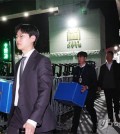- California Assembly OKs highest minimum wage in nation
- S. Korea unveils first graphic cigarette warnings
- US joins with South Korea, Japan in bid to deter North Korea
- LPGA golfer Chun In-gee finally back in action
- S. Korea won’t be top seed in final World Cup qualification round
- US men’s soccer misses 2nd straight Olympics
- US back on track in qualifying with 4-0 win over Guatemala
- High-intensity workout injuries spawn cottage industry
- CDC expands range of Zika mosquitoes into parts of Northeast
- Who knew? ‘The Walking Dead’ is helping families connect
Interview: K-pop songwriter/singer eSNa
By Tae Hong
Even if you’ve never heard of eSNa, a talented singer-songwriter active in South Korea, you could probably sing a few notes of the songs she’s had a hand in bringing to life, from Soyou and Junggigo’s “Some” to Mamamoo’s “Piano Man.”
Her return to her hometown of Los Angeles over the weekend to perform at the 42nd Los Angeles Korean Festival was as meaningful a moment as any for the 27-year-old.
The festival was her first stateside performance since officially debuting under WA Entertainment/Rainbow Bridge Agency (her labelmates include Mamamoo, Basick and Phantom).
Five years ago, eSNa — a UCLA grad who studied jazz vocals — flew to Korea on the whim of a determination to succeed in music there. At the time, she’d been uploading videos to a YouTube channel.
“I just felt like it would be good to do music there. I went there blindly, and until two years ago, before I finally accepted Korea as my home, it was really tough,” she said.
As a songwriter, 2014 was a breakout year for her. “Some,” an R&B dialogue-based collaboration between Sistar vocalist Soyou and soloist Junggigo, swept Korea and became the longest-running top charter of the year.
eSNa acted as both songwriter and lyricist alongside Kim Do-hoon, Xepy and Lil Boi.
“That was a song that was unintentionally easy to write, but ended up needing a lot of work. A lot of it came from my own experiences,” she said. “I think the fact that so many people worked on it was the reason it received so much love. It wasn’t just the perspective of one person but the collected perspectives of many.”
Her sound is heavily R&B, jazzy and swing-inspired. It’s heard in most of her creations, from Wheesung and Gummy’s “Special Love” to a handful of Mamamoo’s critically praised songs.
It’s an indication of a changing K-pop industry, and its listeners, that her tracks get the love they do, she said.
“I’ve never cared too much about what the mass public thinks about my music. I never really was able to reach them, especially in Korea,” she said. “But as I keep living there, I realize the scene is changing. More and more people have begun enjoying non-idol music, and those artists are climbing the charts. That makes me think that my music can see the light, too.”
That’s the behind-the-scenes eSNa. As a singer herself, she faces the same hectic, the ever-evolving, the sometimes-hurtful world of Korean pop music. In April, after the release of “Ahh Oop!”, a collaboration with Mamamoo written by eSNa, she was subject to Netizen derision not for her vocals or her performance but for her looks.
In an updated version of the song, titled “Ahh S***!”, eSNa called out her haters with a final message: “All my ladies out there, you’re beautiful just the way you are.”
“I thought about how to get past [the comments] and decided just letting it go quietly didn’t fit my personality,” she said. “My company suggested we try something using my actual colors. I even cursed during the song, but people had such a positive reaction to it. When things like that happen, I can’t help but think that K-pop has a long way to go still, especially with the imagery of what a celebrity should look like. I’m a person who wants to change that.”
Her next mini album is slated for release Oct. 22.
“Now that I’m known more as a songwriter, I think it’s time for me to show myself as a singer,” she said. “I think, If people listen to my music and like it, that means they like me, too. Because so much of me is in the music itself.”















![넷플릭스 2025년 라인업 공개 [넷플릭스 제공. 재판매 및 DB 금지]](http://www.koreatimesus.com/wp-content/uploads/2025/04/20250415135202671-copy-120x134.jpg)
